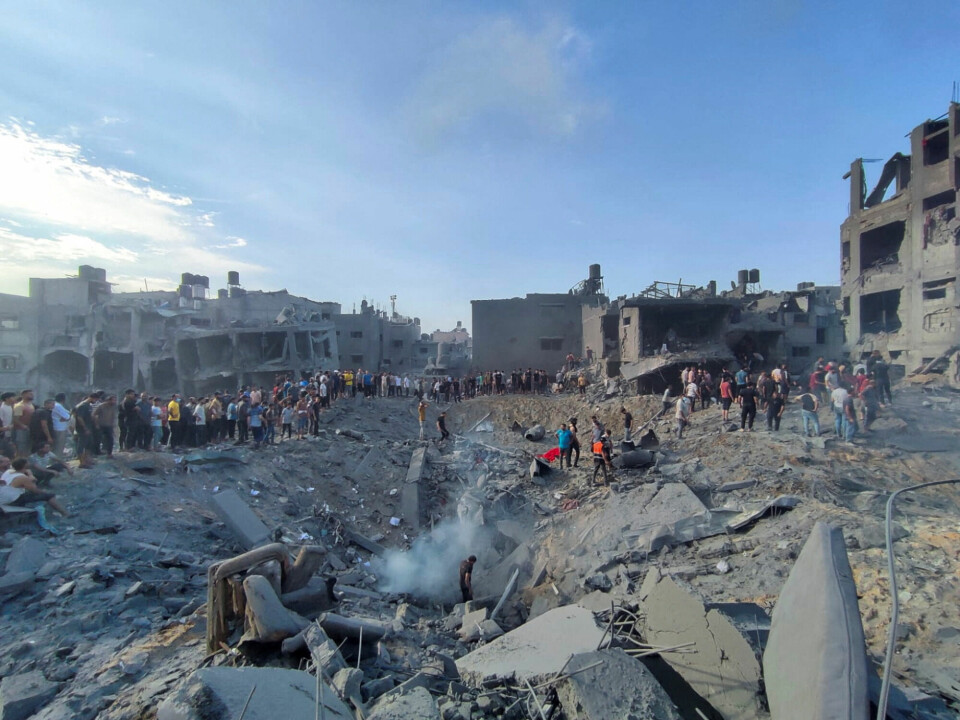
The extent of manipulated news, images, and videos is greater than ever, according to analysts
Fake news and videos make us trust real news less, according to a new study. “This is clearly a concern,” researcher says.
Fake news and misinformation are pouring out of Palestine and Israel.
“A number of analysts say the extent of manipulated news, images, and videos in this war is greater than they have ever seen,” Eskil Grendahl Sivertsen says. He is a special adviser and researcher at the Norwegian Defense Research Establishment (FFI).
One example is a video on X/Twitter allegedly made by the BBC that says Ukraine smuggled NATO-funded weapons to Hamas ahead of the October 7 attack. The BBC was quick to deny that the video came from them. "The video is 100 per cent fake," one of the BBC's journalists said to AP Fact Check.
“Here, Russian profiles use the opportunity to try to weaken support for Ukraine, by spreading false claims that Ukraine has sold Western weapons to Hamas, among other things,” Sivertsen says.
The first-ever study on manipulated videos in war, so-called deepfakes, now shows that the volume of fake news and videos makes people stop trusting real videos as well.
A fake BBC video claiming a Bellingcat investigation shows Ukraine smuggled weapons to Hamas is being pushed by Russian social media users. It's unclear if this is a Russian government disinformation campaign or a grassroots effort, but it's 100% fakehttps://t.co/9bSZg24kgq pic.twitter.com/s4Tn0Ra8pa
— @eliothiggins.bsky.social (@EliotHiggins) October 10, 2023
A flood of fake and real information
How should we deal with this – those of us who read, watch, and share news?
“You have to be aware that the internet and social media are flooded with huge amounts of false information, rumours, manipulated and recycled images,” Sivertsen says.
Sivertsen believes that we have to be sceptical of what we see and trust primarily in credible media with an editorial staff, and institutions that verify their sources and content.
He believes we should not share content we are not sure is real and that is not verified.
“Rather than assessing the image or film itself, it’s easier for you and me to assess the credibility of the source and the story that the image or film purports to illustrate,” Sivertsen says.
Thinks it will get worse
Sivertsen believes the extent of this flood of fake news will continue to increase.
“Disinformation that supports and smears both parties will be further reinforced by commercial actors,” Sivertsen says.
He mentions dubious online newspapers and influencers who want to exploit the situation to increase advertising revenue and their popularity.
Sivertsen says that the Israeli analysis agency Cyabra did a survey in the first 48 hours after the terrorist attack by Hamas.

Analysts found 42,000 fake Hamas accounts that in the first two days produced 321,000 posts and received 531 million views.
Several of the social media accounts had been created one to two years ago and were dormant until they exploded with activity immediately after the terrorist attack on 7 October.
Anti-Muslim propaganda from India
After the attack, the amount of anti-Palestinian and anti-Muslim propaganda has also exploded online.
“Much of this comes from social media accounts in India,” Sivertsen says.
One example is a video of a dozen young girls who allegedly had been taken as sex slaves by a Palestinian fighter. It turns out that the video was instead from an ordinary school trip to Jerusalem. Although the quality of the video is poor, it is possible to see that the girls are casually talking to each other and that they are using their mobile phones.
Despite this, the video was shared several thousand times on X/Twitter with the message that the girls had been taken as slaves. It received over six million views, with most of the posts traceable back to India, according to the Arabic news channel Al-Jazeera.
This video claiming to show Israeli girls taken as sex slaves by Hamas has gone viral with thousands of retweets. There is zero context, they look like they're happy chatting on their phones. And even if in Palestine looks like Jerusalem. Lots of Indian accounts sharing it pic.twitter.com/kHtBmuuH4L
— Marc Owen Jones (@marcowenjones) October 9, 2023
What are the consequences?
“This can have consequences in many areas,” Sivertsen says.
He believes that all this information, real or fake, gets mixed together, and the nuances disappear in what is already a very complex situation with a long history and many people and interests.
“Anti-Israeli, anti-Semitic, anti-Muslim, and anti-Palestinian attitudes are reinforced, and everything is mixed together. This will happen not only in the Middle East, but in Europe and other parts of the world,” he says.
Sivertsen believes that misinformation can, in the worst case, lead to political, military, and personal decisions being taken based on incorrect information.
Studied war-related deepfakes
Sivertsen points out an additional factor.
“Many of us can get fed up with this flood of news, so we consequently stop following and caring because it becomes too difficult to distinguish truth from lies,” he says.
This was also the conclusion of the new study, where researchers investigated the use of deepfakes on X/Twitter in the ongoing war in Ukraine.
Deepfakes are images, video and sound that are created using artificial intelligence. These allow you to exchange faces and voices and thus manipulate the message to be something completely different.
Think of it as a kind a Snapchat filter, only much more advanced.
We stop believing the news
In the new study, Irish researchers looked at the use of deepfakes in war and the consequences of its use on people's view of information. They examined more than 5,000 Twitter posts during the first seven months of 2022.
Researchers saw that many of the users posted posts that were sceptical of real videos, not fake ones. So a lot of information that people referred to as deepfakes was actually real.
The study was a qualitative investigation, where the researchers analysed Twitter messages and uncovered what they believed to be a trend.
In a number of the posts, users said that they could no longer trust information that came out of the war. The researchers therefore believe that the very fear of deepfakes has caused people to lose confidence in all information about the war in Ukraine — even real information.
Here's an example of a deepfake video from 2022 in which Ukrainian President Volodymyr Zelenskiy apparently surrenders to the Russians:
Real photos and videos lose value
Sivertsen agrees with the Irish researchers.
“This is clearly a concern. We are facing an explosion of AI-generated content, in images, films, sound, and text. Without labelling or technology that can easily reveal what is fake and real, it is likely that film and images will lose their documentary value and that we will become more sceptical of everything we see,” he says.
That will make it easier to sow doubt, simply by claiming that real images and films are deepfakes, according to Sivertsen.
———
Translated by Nancy Bazilchuk
Read the Norwegian version of this article at forskning.no
Reference:
Twomey et al. Do Deepfake Videos Undermine our Epistemic Trust? A thematic analysis of tweets that discuss deepfakes in the Russian invasion of Ukraine, PLOS ONE, 2023. DOI: 10.1371/journal.pone.0291668





































